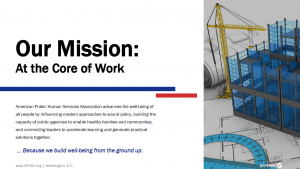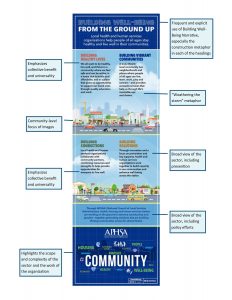Building Reframing Into Organizational Culture
July 26, 2018True reframing integration means weaving the approach into the fabric of your organization, making it automatic and easier to adopt for staff now and in the future. Beyond simply reframing specific content, sustainability is achieved when reframing is established as the lens through which to make communications, development, and policy decisions across the organization. One of our longtime reframing partners, the American Public Human Services Association (APHSA), has recently completed two products that expertly demonstrate how to fully incorporate reframing in meaningful ways internally and in key external products.
Strategy Guidelines
APHSA recently shared with us its updated Strategic Playbook for 2018-2022, which is approved by the Executive Governing Board of Directors and guides the work of its members, volunteer leaders, key partners, and staff. The Strategic Playbook is unique and impressive in several ways. Primarily, it frequently and thoroughly applies the full Building Well-Being Narrative. For example, language highlighting the value of human potential and well-being, the construction metaphor, and life-cycle examples are used within a number of foundational statements:
- Vision: “Thriving Communities Built on Human Potential”
- Mission: “Because we build well-being from the ground up”
- Guiding Principles: “We are relentless in our pursuit of the limitless possibilities of human potential.”
- Theory of Action: “A clear line of sight to population health and well-being using framing principles.”

According to APHSA’s Jessica Garon, “with our reframed vision and mission, we wanted to accurately reflect the shared belief of leaders across the country—our members—that health and human services are a cornerstone to building a strong and healthy nation made up of thriving communities,” while the theory of action offers the key elements that guide the steps to accomplishing the vision and mission. In addition, APHSA implemented other key framing strategies to combat the common negative misconceptions that research shows the public have about human services. These include maintaining a positive tone in statements like the Guiding Principles rather than rely on crisis language, emphasizing the broad definition of both well-being (economic, developmental, familial, health, etc.) and human services, and accentuating the focus on services and benefits for all people in all places.
Of equal significance, the Strategic Playbook highlights effective framing as a whole, committing to using “framing science to drive our solutions” and directly explaining why they are using the language they chose. For example, one of their Six Key Levers is “Applying Science and Design,” including the “use of framing research and evidence-informed narratives.” They specifically aim to trigger the following values: human potential, pragmatism, and prevention.

External Products
One way to see the framing approach take hold is through its use in new external-facing products. A prime example is the recently released infographic (see overview below) from APHSA in collaboration with their National Council of Local Service Administrators, which is comprised of local agency leaders and serves as one of their peer councils. Intentionally tying back to APHSA’s updated vision and mission statements, the infographic was created to help illustrate through both effective framing and imagery the role that agencies play in creating thriving communities built on human potential.
SPOTLIGHT ON
A recent article in the Nonprofit Quarterly asks “Who Are You Talking To? The Peril of Assumptions in Nonprofit Communications.” Author Jennifer Nichols, a researcher with our partner the FrameWorks Institute, asserts that strategic communicators must assume their audience has “no prior knowledge but many preexisting ideas” and proposes explanatory chains as an effective tool for advocacy messages. Explanatory chains present an unbroken, linear trail that logically connects causes to consequences and fills in gaps in the audience’s understanding. Using examples from union organizing and housing, the article clearly identifies the reasons behind and recipe for creating strong explanatory chains.


